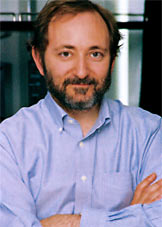

The Nobel Prize in Physiology or Medicine 2006
Andrew Z. Fire and Craig C. Mello for their discovery of
"RNA interference - gene silencing by double-stranded RNA"
스웨덴 카롤린스카연구소 노벨상 선정위원회는 10월 2일, RNA 간섭현상(RNAi)'을 처음으로 발견한 미국 스탠퍼드대 의대 앤드루 Z. 파이어(47) 교수와 매사추세츠의대 크레이그 C. 멜로(46) 교수를 올해의 노벨 생리의학상 공동 수상자로 발표했다.
siRNA는 이중가닥의 RNA(double-stranded RNA)가 Dicer에 의해 절단되어 생성되는 21-25nt 크기의 작은 RNA조각으로 상보적인 서열을 갖는 mRNA에 특이적으로 결합하여 단백질 발현을 억제하는 것으로 밝혀졌다.
이들의 존재는 1998년 미국 카네기 연구소의 Andrew Fire와 Massachusetts 의과대학의 Craig Mello 연구팀의 실험을 통해 처음 확인되었는데, 외부의 이중 가닥의 RNA를 선충에게 주입했을 때 상보적인 세포 내부의 mRNA와 서열특이적으로 결합해 유전자 침묵(gene silencing)을 유도하는 기능을 확인했고, 이를 계기로 이런 현상을 RNA interference(RNAi)라고 부른다.
(관련 자료: 2003년 핫이슈 microRNA)
About the Nobel prize Laureates
Photo: Stanford
Andrew Z. Fire:
Stanford University School of Medicine
Stanford, CA, USA
b. 1959
Photo: UMASS
Craig C. Mello :
University of
Massachusetts Medical School
Worcester, MA, USA
b. 1960
Press Release
The 2006 Nobel Prize in Physiology or Medicine
2 October 2006
The Nobel Assembly at Karolinska Institutet has today decided to award
The Nobel Prize in Physiology or Medicine for 2006
jointly to
Andrew Z. Fire and Craig C. Mello
for their discovery of
"RNA interference - gene silencing by double-stranded RNA"
Summary
This year's Nobel Laureates have discovered a fundamental mechanism for controlling the flow of genetic information. Our genome operates by sending instructions for the manufacture of proteins from DNA in the nucleus of the cell to the protein synthesizing machinery in the cytoplasm. These instructions are conveyed by messenger RNA (mRNA). In 1998, the American scientists Andrew Fire and Craig Mello published their discovery of a mechanism that can degrade mRNA from a specific gene. This mechanism, RNA interference, is activated when RNA molecules occur as double-stranded pairs in the cell. Double-stranded RNA activates biochemical machinery which degrades those mRNA molecules that carry a genetic code identical to that of the double-stranded RNA. When such mRNA molecules disappear, the corresponding gene is silenced and no protein of the encoded type is made.
RNA interference occurs in plants, animals, and humans. It is of great importance for the regulation of gene expression, participates in defense against viral infections, and keeps jumping genes under control. RNA interference is already being widely used in basic science as a method to study the function of genes and it may lead to novel therapies in the future.
References
Fire A., Xu S.Q., Montgomery M.K., Kostas S.A., Driver S.E., Mello C.C. Potent and specific genetic interference by double-stranded RNA in Caenorhabditis elegans. Nature 1998; 391:806-811.
Andrew Z. Fire - Curriculum Vitae
Address : Departments of Pathology and Genetics
Stanford University School Of Medicine 300 Pasteur Drive - L235
Stanford, CA 94305-5324
Links to other sites
Andrew Z. Fire's web page
Andrew Fire's Profiles
Stanford University School of Medicine
About Andrew Z. Fire
Fire was born at Stanford Hospital and raised in Sunnyvale, Calif.
He received bachelor’s in mathematics in 1978 from UC-Berkeley. At the age of 19 he went to the Massachusetts Institute of Technology where he earned his PhD in biology in 1983. Fire was later a Helen Hay Whitney Postdoctoral Fellow in Cambridge, England, where he worked at an MRC Laboratory of Molecular Biology group headed by Nobel laureate Sydney Brenner.
Between 1986 and 2003, Fire was a staff member of the Carnegie Institution of Washington’s Department of Embryology in Baltimore. The initial work on double stranded RNA as a trigger of gene silencing was published while Fire and his group were at the Carnegie Labs.
Fire was an adjunct professor in the Department of Biology at Johns Hopkins University starting in 1989 and joined the Stanford faculty in 2003. Throughout his career, all of the major work in Fire’s lab has been supported by research grants from the US National Institutes of Health.
Publications (>>view full list )
Fire A, "Nucleic acid structure and intracellular immunity: some recent ideas from the world of RNAi." Q Rev Biophys 2006; 1-7
Fire A, Alcazar R, Tan F "Unusual DNA structures associated with germline genetic activity in Caenorhabditis elegans." Genetics 2006.
Blanchard D, Hutter H, Fleenor J, Fire A "A differential cytolocalization assay for analysis of macromolecular assemblies in the eukaryotic cytoplasm." Mol Cell Proteomics 2006.
Moreno-Herrero F, Seidel R, Johnson SM, Fire A, Dekker NH "Structural analysis of hyperperiodic DNA from Caenorhabditis elegans." Nucleic Acids Res 2006; 34: 10: 3057-66.
Foehr ML, Lindy AS, Fairbank RC, Amin NM, Xu M, Yanowitz J, Fire AZ, Liu J "An antagonistic role for the C. elegans Schnurri homolog SMA-9 in modulating TGFbeta signaling during mesodermal patterning." Development 2006; 133: 15: 2887-96. (>>view full list )
Craig C. Mello - Curriculum Vitae
Links to other sites
For a brief biography of Dr. Mello
The Mello Lab
Mello's research, visit his Howard Hughes website
University of Massachusetts Medical School
Academic Education and Appointments
Dr. Mello holds his BS in biochemistry from Brown University and his PhD in Cellular and Developmental Biology from Harvard University. He was a postdoctoral fellow at the Fred Hutchinson Cancer Research Center before coming to UMMS in 1994. He is also a 1995 Pew Scholar in the Biomedical Sciences.
Selected Honours and Awards
2006 Nobel Prize in Physiology or Medicine
Gairdner Foundation International Award
National Academy of Sciences Award in Molecular Biology
Wiley Prize in Biomedical Sciences
Warren Triennial Prize, Massachusetts General Hospital
Massry Prize
Publications (>> PubMEd)
Duchaine TF, Wohlschlegel JA, Kennedy S, Bei Y, Conte D Jr, Pang K, Brownell DR, Harding S, Mitani S, Ruvkun G, Yates JR 3rd, Mello CC. "Functional proteomics reveals the biochemical niche of C. elegans DCR-1 in multiple small-RNA-mediated pathways." Cell. 2006 Jan 27;124(2):343-54.
Shirayama M, Soto MC, Ishidate T, Kim S, Nakamura K, Bei Y, van den Heuvel S, Mello CC. "The Conserved Kinases CDK-1, GSK-3, KIN-19, and MBK-2 Promote OMA-1 Destruction to Regulate the Oocyte-to-Embryo Transition in C. elegans." Curr Biol. 2006 Jan 10;16(1):47-55. Epub 2005 Dec 15.
Nakamura K, Kim S, Ishidate T, Bei Y, Pang K, Shirayama M, Trzepacz C, Brownell DR, Mello CC. "Wnt signaling drives WRM-1/beta-catenin asymmetries in early C. elegans embryos." Genes Dev. 2005 Aug 1;19(15):1749-54.
Wang D, Kennedy S, Conte D Jr, Kim JK, Gabel HW, Kamath RS, Mello CC, Ruvkun G. "Somatic misexpression of germline P granules and enhanced RNA interference in retinoblastoma pathway mutants." Nature. 2005 Jul 28;436(7050):593-7.
Chen CC, Simard MJ, Tabara H, Brownell DR, McCollough JA, Mello CC. "A member of the polymerase beta nucleotidyltransferase superfamily is required for RNA interference in C. elegans." Curr Biol. 2005 Feb 22;15(4):378-83. (>> PubMEd)
Laureates
2005 - Barry J. Marshall, J. Robin Warren
2004 - Richard Axel, Linda B. Buck
2003 - Paul C. Lauterbur, Sir Peter Mansfield
2002 - Sydney Brenner, H. Robert Horvitz, John E. Sulston
More...





